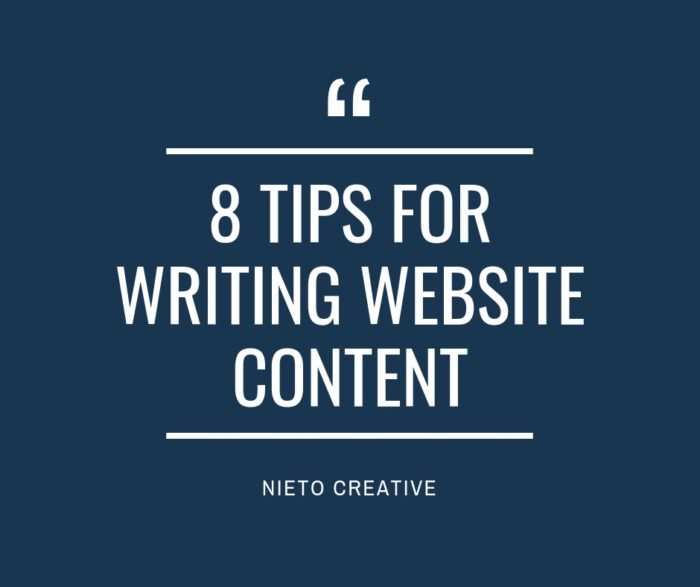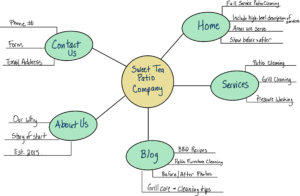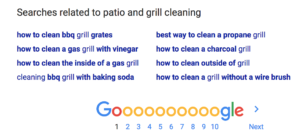8 Tips on How to Write Content for your Website

Deciding to move forward and get a website for your business is one of the first steps to realizing your dreams as an entrepreneur. Now the hard work begins! We all wish we could just click the ‘buy now’ button and magically get a website that reflects our brand and contains the exact words that describes your business and captures the customer’s attention. Unfortunately, it isn’t as easy as that.
You can leave the design and branding up to us, but developing the content that best reflects your business is oftentimes best done by you, the business owner. You know your business and customers better than we do, but we can certainly help!
How you write your content can be an overwhelming task. Here are 8 tips that can help.
1. Build an outline of your pages.
Think about the common pages you see in most websites: Home, About, Contact, Blog, Services/Products, etc. and then write a small summary of the information you may display on that page.
One of the techniques I have found to use at this stage is Mind Mapping. Here is an example of using Mind Map I developed for Sweet Tea Patio Company. This was created using my iPad Pro on the GoodNotes App. You can also use a simple pen and paper.

2. Write with your customers’ needs in mind.
One of the most important messages we can give here is to write content with your customer’s problems in mind. How are you solving their problems? Is your content speaking to that problem?
3. Remember, you are not the hero of the story.
Here at Nieto Creative we subscribe to the StoryBrand concept from the book Building a StoryBrand by Donald Miller. It is important for you to realize the customer is looking for you to be their guide, not their hero. They are the hero. Tell them how you can help them find more time, status, or growth rather than telling them how amazing you are.
Ask yourself these questions:
- How does your product help them find more time, status or money?
- What problem are you solving for them?
- What kind of experience will they have it they use your product or service?
- Am I making it clear on the next steps they should take?
- It is easy for them to understand how to engage with my business from each page?
4. Make it short and sweet and “skimmable.”
Remember, less is more. People will decide if they want to learn more about you within 3 seconds. Don’t make it hard for them to hit the high points. Use lists, bolded words and summary statements to guide them through your content. If they like what they see at the summary level, it is likely that they will dig into the rest of the content.
5. Avoid jargon.
Use familiar words and avoid jargon that the reader might not understand. If you are a photographer and say ‘depth of field’, the user might not understand that, but if you say ‘blurry background’ they will likely understand what you are talking about. If you aren’t sure, ask a few friends that may not be as close to your business as yourself.
6. Write for Google.
Your content should contain words that your target audience would search for while looking for your type of product or service. Do your research and ask yourself these questions:
- What words are my competitors using?
- Am I a local business that should be using local keywords? i.e. City, State
- What keyword phrases should I be using? i.e. “patio and grill cleaning”
- Am I considering related terms? Look at the bottom of your search screen and consider a way for your content to reflect those search terms.

Here are some resources that could help you write content for your website that is keyword friendly:
○ Moz Keyword Explorer
○ Google AdWords Keyword Planner Tool
○ Google Trends
○ Wordtracker’s Free Basic Keyword Demand
7. Don’t forget the clear call to actions.
Make sure your customer understands what you want them to do next. Remember in Tip #3 above, it is important for you to be the guide for your site visitor. Guide your customer by providing them clear call to actions. Do you want them to sign up for your newsletter, download content or make an appointment? Make sure the links or buttons reflect what your end goal is and make it easy to find.
8. Finally, align with your design.
Your website copy and website design should work well together. Having an idea of where the content will live and how much space you have could be an important part of finalizing the entire site. If you aren’t sure yet, write your content with the understanding you might have to cut it down later to look cohesive with your design elements. Reduce content and add white space.
